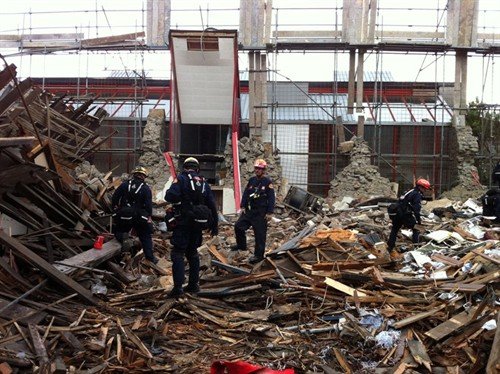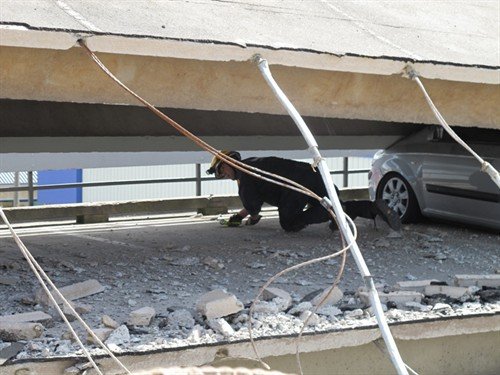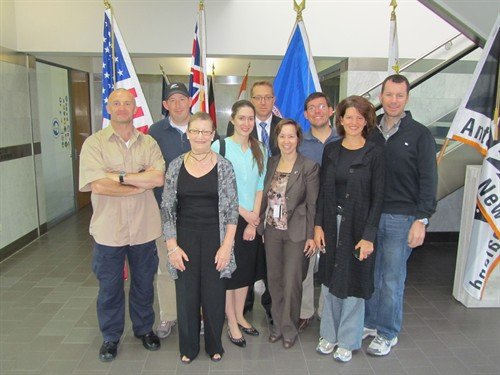United States Embassy in New Zealand Collection
The United States Embassy in New Zealand (US Embassy) has generously donated a collection of material to the UC CEISMIC archive from their response to the Canterbury earthquakes. This includes photographs from their team on the ground in Christchurch; blog posts from David Huebner, the United States Ambassador to New Zealand and Samoa; and media releases from the US Embassy, the US House of Representatives Congressional Delegation, and the Office of the Press Secretary in the US White House.
The United States of America Embassy New Zealand (US Embassy) in Wellington along with the Consulate General in Auckland provides assistance to American citizens in New Zealand. After the 22 February 2011 earthquake, the US Embassy responded with two goals in mind:
- To locate and assist American citizens in distress, and to mobilize US Government resources;
- To assist local authorities in preserving life and addressing urgent humanitarian needs.
The material in the US Embassy collection demonstrates that both of these goals were achieved, revealing the huge amount of support the USA gave to Christchurch after the February earthquake.
Within 24 hours of the earthquake, a USAID Disaster Assistance Response Team was sent to Christchurch, including seventy specialised personnel from the Los Angeles County Fire Department Urban Search and Rescue Team and 40 tonnes of supplies and high-tech equipment:
Members of the USAID Disaster Assistance Response Team (DART) searching through the rubble of a collapsed building in the Christchurch central city.
The team stayed in Christchurch for two weeks, working around the clock to search rubble for trapped survivors and victims in sixteen blocks of the central city. They also searched an additional two dozen structures in the wider central business district, helped assess the structural stability and potential deconstruction of numerous buildings, provided USAR support at key sites such as the Christ Church Cathedral and Pyne Gould Guinness, and conducted damage assessments in many of the city's hard-hit eastern suburbs.
A member of the USAID Disaster Assistance Response Team (DART) crawling in between two layers of the Smiths City car park.
Before they left, the USAID DART team gifted the New Zealand Fire Service approximately $600,000 worth of sophisticated detection and rescue equipment as well as other supplies. Part of this gift was the Delsar Life Detector, which uses a seismic sensor to detect movement and an acoustic sensor to detect subtle sounds that might alert rescue personnel to the presence of a living person in the voids of a collapsed building. Also in the transfer was the SearchCam Victim Location System, which features a telescoping probe that extends the rescuer's viewing area during structural collapse, breaching, and vehicle extrication operations.
The other task the US Embassy performed after the 22 February 2011 earthquake was assisting American citizens in distress, as well as distributing information to any other displaced persons they encountered, regardless of nationalities. This was carried out by approximately one dozen US Embassy staff who were already in Christchurch for meetings when the earthquake struck. These staff members remained in Christchurch, working around the clock to visit each triage and welfare centre to establish contact with American citizens, determine their condition, and facilitate necessary assistance.
Members of the US Embassy in New Zealand at the International Antarctic Centre in Christchurch.
The US Consular officials in Auckland and Wellington also fielded hundreds of calls from American citizens and assisted in replacing passports and other travel documents lost or destroyed in the quake. American Citizens service stations were set up at both the military and civilian airports in Wellington and Auckland.
The US Embassy's rapid and dedicated response to the 22 February 2011 earthquakes is evident in this collection. The deployment of the US Embassy staff and the USAID Disaster Response Team in Christchurch undoubtedly saved lives and ensured the safe return of many US and other international citizens. It is an honour for UC CEISMIC to be able to house the photographs, media releases, and blog posts created by the team, and we believe they will be of great use to researchers in years to come, as they study the emergency response to the Canterbury earthquakes.



